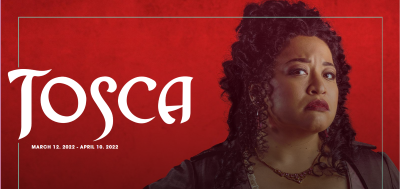YAY OR NAY? IT’S A TOSCA-UP
I was really looking forward to seeing this season’s new-to-Chicago production of my favorite Puccini opera, but this Tosca did not live up to my expectations. It’s not a bad production, but neither is it a great one; it’s simply okay. The best thing about it is its diversity. Most notably, the conductor (Eun Sun Kim) and director (Louisa Muller) are both women, while three of the principal roles are performed by African Americans (Michelle Bradley, Russell Thomas, and Leroy Davis), one by a Filipino American (Rodell Rosel), and one by an Argentine (Fabián Veloz).
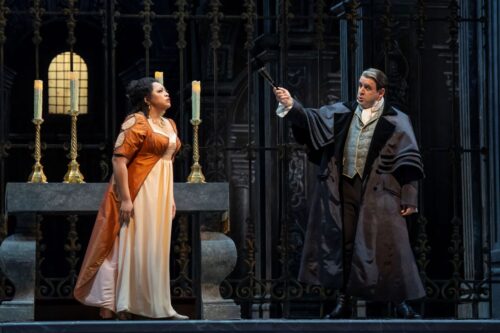 Michelle Bradley and Fabián Veloz - photo Cory Weaver
Michelle Bradley and Fabián Veloz - photo Cory WeaverBased on Victorien Sardou’s 1887 play La Tosca, Puccini’s opera premiered in 1900. The action unwinds during the Napoleonic wars, as Rome is caught between the competing armies of France and Naples. In the midst of this conflict, the Roman noble Angelotti (played by Rivers Hawkins) escapes from Castel Sant’Angelo. The painter Mario Cavaradossi tries to hide Angelotti, but he is arrested and tortured by Baron Scarpia, who wants Cavaradossi’s lover Tosca for himself. Tosca gives up Angelotti to save Cavaradossi and kills Scarpia, but Cavaradossi is executed anyway. Adding to the tragedy, both Angelotti and Tosca commit suicide in order to avoid arrest.
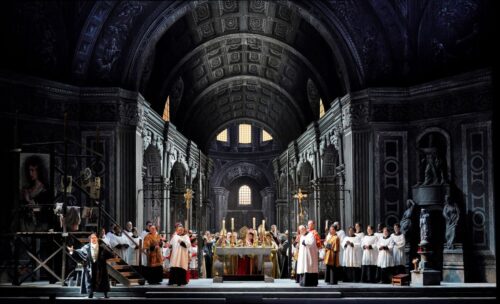 The Company of Tosca - photo Cory Weaver
The Company of Tosca - photo Cory WeaverTosca begins in a church, develops in a palace, and ends in a fortress. Each of these settings are actual places: Sant’Andrea del Valle, the Palazzo Farnese, and Castel Sant’Angelo. Set designer Jean-Pierre Ponnelle (1932-1988) does a great job evoking these settings, but each is flawed. Why, for example, in a church covered in wall and ceiling murals, is Cavaradossi painting on canvas? Or why is the table at which Scarpia dines in the palace the size of a side table? It looks ridiculous and completely out of proportion. And why, oh why, is the statue of St. Michael on the parapet of the castle a two-dimensional work, such that the audience sees only the blank side?
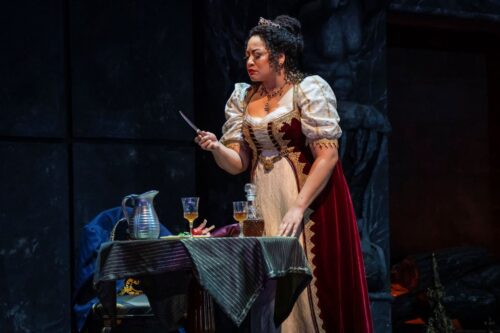 Michelle Bradley - photo Todd Rosenberg
Michelle Bradley - photo Todd RosenbergMarcel Escoffier’s (1910-2001) costume designs are similarly evocative, but lackluster. Tosca’s drab gowns are not at all what one would expect from a diva, while most of the men wear black suits or army uniforms. The most interesting clothing are the vestments worn by the clergy in Act I, though I can’t figure out why the sacristan is dressed like a priest when he clearly states that he isn’t one.
Ms. Muller’s direction is fine, but not particularly interesting. By contrast, John Caird’s direction in Lyric’s last Tosca production (2015) was much more original, if less than faithful to his source material. Though Muller doesn’t obscure the story, she doesn’t particularly illuminate it either, preferring to keep much of the action offstage. She goes all in for processions and ritual, especially of the ecclesiastical and martial kind, but fails to get the details right. Even the pacing isn’t quite right, but that could be due to the acting.
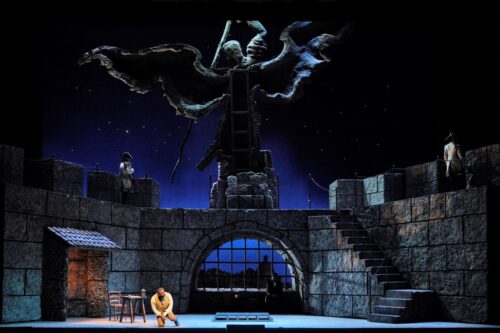 Russell Thomas - photo Cory Weaver
Russell Thomas - photo Cory WeaverIn her Lyric debut and role debut as the eponymous heroine, soprano Michelle Bradley is frankly disappointing. Act II lags because of her unconvincing and tentative performance; her role’s most famous aria, “Vissi d’arte,” goes by almost unnoticed. There is nothing diva-like in her acting or her singing, despite the demands of the role. Neither is baritone Fabián Veloz’s Scarpia, also a Lyric debut, particularly menacing; he sings well enough, but his acting is superficial and bland. Rodell Rosel, on the other hand, is an excellent actor — one that Lyric audiences know well. He may not have the most beautiful voice, but his technique is nothing short of perfection. Tenor Russell Thomas as Cavaradossi simply seemed tired, as if he was saving all his energy for his famous Act III aria “E lucevan le stelle.”
Russell Thomas and Michelle Bradley - photo Cory Weaver
Even if this production isn’t scintillating, it boasts Puccini’s most gorgeous score. Swift and compact, without a single wasted moment or prolix line, Tosca opens without an overture to set the stage. Instead, there is an abundance of dramatic orchestration, especially for brass and bells, as well as welcome Wagnerian leitmotifs, ably conducted by Ms. Sun Kim. Despite a lackluster opening night, this production could improve immensely during its month-long run if Bradley gains a little more confidence in the role and Thomas gives a more sustained, energetic performance.
Stay tuned for Terence Blanchard’s jazzy opera Fire Shut up in My Bones, which opens March 24.
photos by Todd Rosenberg and Cory Weaver
Tosca
Lyric Opera of Chicago
Civic Opera House, 20 N. Wacker Drive
ends on April 10, 2022
for tickets, call 312.827.5600
or visit Lyric Opera
for more info shows, visit Theatre in Chicago
